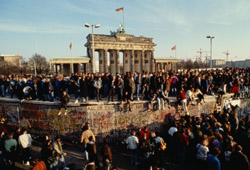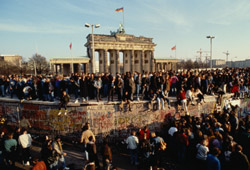East and West Berliners celebrating fall of the Berlin Wall, November 1989
Berlin is about to have a big party. For a week this November, Germany’s capital city will host a festival to celebrate a historic day thirty years ago. In November 1989, citizens of what were then East Germany and West Germany dismantled the Berlin Wall, which had divided the city during the Cold War. It would be the first step toward the country’s reunification.
There wasn’t always a lot to celebrate in Berlin. Following Germany’s 1945 surrender in World War II, much of the city was in ruins. The Allies split the country into four occupation zones. They also divided Berlin: the Soviet Union controlled the eastern sector, and the United States, Great Britain, and France controlled the western half. Tensions mounted between 1949 and 1961, during which time an estimated 2.5 million East Germans—including skilled workers, professionals, and intellectuals—fled to West Germany to escape communism. This exodus threatened to destroy East Germany’s economic viability.
In August 1961, East German soldiers and Berlin police began building a barbed wire and cinderblock wall, dividing the city. Suddenly, people who were previously able to travel freely between East and West Berlin to work, shop, or visit family were not permitted to cross the border. The temporary barrier was soon replaced by two, 12-foot concrete structures, 160 yards apart, spanning about 28 miles. Barbed wire and spikes topped the walls. Hundreds of gun-wielding watchtower guards—aided by dogs and floodlights—monitored the “death strip,” the dirt and sand area between the walls filled with land mines. They shot anyone trying to escape to freedom.
Despite the deadly risk, more than 5,000 East Germans succeeded in crossing the border—climbing over barbed wire, jumping out of windows next to the wall, crawling through sewers. Some even flew over the wall in a hot-air balloon. According to researchers, at least 137 defectors died trying to escape.
A symbol of the Cold War, the Berlin Wall stood for twenty-eight years until a wave of pro-democracy protests swept through Eastern Europe in October 1989. When East Berlin’s Communist Party announced on November 9 that citizens were free to cross the border, East and West Berliners chanted, “Tor auf! (Open the gate!)” Amid ecstatic cheers, using hammers and picks, citizens from both sides of the city jubilantly chipped away chunks of the wall.
Image credit: © Tom Stoddart/Getty Images
Related Links:
- 10 Things You May Not Know about the Berlin Wall
Did the fall of the Berlin Wall happen by mistake? Find out in this article.
(Source: History.com, October 22, 2019) - Thirty Years after Fall of Berlin Wall, a Citywide Celebration
Learn about Berlin’s commemoration of the Berlin Wall’s fall.
(Source: Smithsonian Magazine, August 29, 2019) - Where Have All the Fragments Gone?
This article traces how pieces of the former Berlin Wall “migrated” to places throughout the world.
(Source: Lapham’s Quarterly, November 5, 2019) - Cycling the Death Strip: Berlin Wall by Bicycle
Follow this 99-mile cycling tour of the “Berlin Wall Trail.”
(Source: CNN, October 6, 2014) - The History of Bernauer Strasse
This article explains how the Berlin Wall destroyed urban space and human lives.
(Source: The Berlin Wall Memorial; accessed November 4, 2019)





